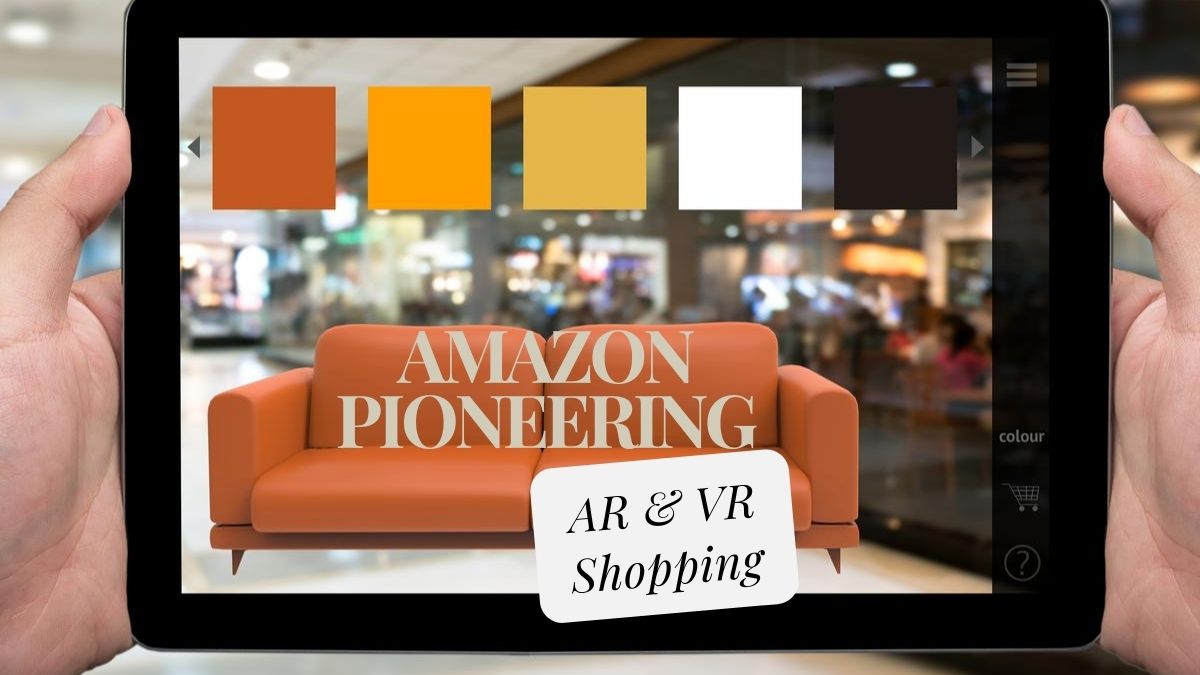Amazon has long been at the forefront of e-commerce innovation. From personalized recommendations to one-click purchases, the company has revolutionized online shopping. Now, Amazon is leveraging augmented reality (AR) and virtual reality (VR) technologies to redefine the retail experience once again. This detailed article will explore how Amazon is pioneering AR and VR shopping, examining the technologies, strategies, and potential impacts on the future of retail.
I. Introduction
In an increasingly digital world, the retail industry is undergoing rapid transformation. Augmented reality (AR) and virtual reality (VR) are at the heart of this evolution, offering immersive experiences that bridge the gap between physical and digital shopping. Amazon, known for its relentless pursuit of innovation, is leading the charge in integrating these technologies into its platform. This article delves into Amazon’s efforts to pioneer AR and VR shopping, exploring the current landscape, technological advancements, strategic initiatives, and future prospects.
II. Understanding AR and VR Technologies
Augmented Reality (AR)
AR enhances the real-world environment by overlaying digital information, such as images, videos, and 3D models, onto a user’s view. This technology allows users to interact with both physical and virtual elements seamlessly. In the retail context, AR can enable customers to visualize products in their own space, try on virtual clothing or access additional product information through their smartphones or AR glasses.
Virtual Reality (VR)
VR immerses users in a completely digital environment, often through the use of VR headsets. This technology creates a sense of presence in a virtual space, allowing users to explore and interact with virtual stores, products, and environments. In retail, VR can offer fully immersive shopping experiences, virtual store tours, and interactive product demonstrations.
III. Amazon’s AR and VR Initiatives
Amazon has been actively exploring AR and VR technologies to enhance the shopping experience for its customers. These initiatives are part of a broader strategy to stay ahead in the competitive e-commerce landscape.
Amazon AR View
One of Amazon’s key AR initiatives is the AR View feature, available through the Amazon app. AR View allows customers to visualize products in their own environment using their smartphone cameras. By selecting the AR View option, users can place a digital representation of a product, such as furniture or electronics, in their living space. This helps customers make more informed purchasing decisions by seeing how the product fits and looks in their home.
Room Decorator
Building on the success of AR View, Amazon introduced the Room Decorator feature. This advanced AR tool allows customers to design entire rooms using multiple products from Amazon’s catalog. Users can select furniture, decor, and other items, arranging them in their space to create a cohesive design. Room Decorator also provides recommendations and styling tips, enhancing the overall shopping experience.
Virtual Try-On
Amazon’s Virtual Try-On feature focuses on fashion and accessories. Using AR technology, customers can try on virtual clothing, shoes, and accessories using their smartphone cameras. This feature helps address one of the biggest challenges in online fashion retail—ensuring the right fit and style. By providing a virtual fitting room experience, Amazon aims to reduce return rates and increase customer satisfaction.
Amazon Explore
Amazon Explore is a platform that offers live, interactive virtual experiences. While not strictly an AR or VR initiative, Amazon Explore leverages similar technologies to provide immersive experiences. Customers can book virtual tours, attend cooking classes, or explore new destinations with local guides, all from the comfort of their homes. This initiative highlights Amazon’s commitment to offering unique, experiential content.
Amazon Sumerian
Amazon Sumerian is a development tool that enables the creation of AR and VR applications. With Sumerian, developers can build immersive experiences without requiring extensive expertise in 3D graphics or programming. This tool supports the creation of interactive shopping experiences, virtual showrooms, and training simulations, expanding Amazon’s capabilities in the AR and VR space.
IV. Technological Advancements Driving AR and VR
Several technological advancements are driving the development and adoption of AR and VR in retail. Amazon is leveraging these innovations to enhance its AR and VR initiatives.
Improved Hardware
The availability of advanced hardware, such as AR-capable smartphones and VR headsets, has made immersive experiences more accessible to consumers. Devices like Apple’s ARKit and Google’s ARCore enable high-quality AR experiences on a wide range of smartphones. Meanwhile, VR headsets like the Oculus Rift and HTC Vive offer immersive virtual environments.
Advanced Computer Vision
Computer vision technology, which allows computers to interpret and understand visual information, is critical for AR and VR applications. Amazon utilizes computer vision algorithms to accurately place virtual objects in real-world environments and track user movements in VR spaces. This technology enhances the realism and interactivity of AR and VR experiences.
Machine Learning and AI
Machine learning and artificial intelligence (AI) play a crucial role in personalizing AR and VR experiences. Amazon uses AI to analyze customer preferences, recommend products, and optimize the placement of virtual objects. For example, AI algorithms can suggest complementary products in the Room Decorator feature or recommend virtual try-ons based on a customer’s style history.
5G Connectivity
The rollout of 5G networks is expected to significantly impact AR and VR adoption. With higher bandwidth and lower latency, 5G enables smoother and more responsive AR and VR experiences. This improved connectivity supports real-time interaction with virtual content, enhancing the overall quality of immersive shopping experiences.
V. Strategic Initiatives and Partnerships
Amazon’s AR and VR efforts are supported by strategic initiatives and partnerships aimed at driving innovation and adoption.
Collaboration with Tech Companies
Amazon collaborates with leading technology companies to develop and integrate AR and VR solutions. Partnerships with companies like Apple, Google, and Microsoft ensure compatibility with the latest AR and VR hardware and software. These collaborations also enable Amazon to leverage cutting-edge technologies and best practices.
Acquisitions and Investments
Amazon has acquired several companies specializing in AR, VR, and related technologies. For example, the acquisition of Body Labs, a company focused on 3D body scanning and modeling, supports Amazon’s Virtual Try-On initiatives. Investments in startups and technology firms also help Amazon stay at the forefront of innovation in AR and VR.
Developer Support and Ecosystem
Amazon supports developers through tools like Amazon Sumerian and AWS (Amazon Web Services). By providing robust development platforms and cloud services, Amazon enables developers to create and deploy AR and VR applications efficiently. This support helps build a vibrant ecosystem of AR and VR content, enriching the shopping experience for customers.
VI. Impact on the Retail Industry
Amazon’s pioneering efforts in AR and VR shopping have significant implications for the retail industry. These technologies are poised to transform various aspects of the shopping experience.
Enhanced Customer Experience
AR and VR technologies enhance the customer experience by providing immersive, interactive, and personalized shopping journeys. Customers can visualize products in their environment, try on virtual clothing, and explore virtual stores, leading to more informed purchasing decisions and higher satisfaction.
Reduced Return Rates
One of the key challenges in e-commerce is the high return rate, often due to mismatched expectations and product fit issues. AR and VR technologies address this problem by allowing customers to see and interact with products virtually before making a purchase. This reduces the likelihood of returns and improves operational efficiency for retailers.
Increased Engagement and Conversion
Immersive AR and VR experiences capture customers’ attention and keep them engaged for longer periods. By offering interactive and enjoyable shopping journeys, retailers can increase conversion rates and drive sales. Amazon’s AR View, Virtual Try-On, and Room Decorator features exemplify how engaging experiences can lead to higher customer satisfaction and loyalty.
Competitive Advantage
Amazon’s leadership in AR and VR shopping sets it apart from competitors, reinforcing its position as an innovation leader in the retail industry. By continuously investing in these technologies, Amazon not only attracts tech-savvy consumers but also sets new standards for the industry. Competitors must adapt and innovate to keep pace with Amazon’s advancements.
VII. Challenges and Considerations
While AR and VR hold great promise for the future of retail, there are several challenges and considerations that Amazon and other retailers must address.
Technical Limitations
Despite significant advancements, AR and VR technologies still face technical limitations. Issues such as limited field of view, latency, and hardware costs can impact the quality and accessibility of AR and VR experiences. Continuous innovation and improvements in hardware and software are necessary to overcome these challenges.
Privacy and Security
AR and VR applications often require access to personal data, such as location, preferences, and visual information. Ensuring the privacy and security of this data is critical to maintaining customer trust. Amazon must implement robust data protection measures and transparent privacy policies to address these concerns.
User Adoption
Widespread adoption of AR and VR shopping depends on user willingness to embrace new technologies. While younger, tech-savvy consumers may readily adopt AR and VR experiences, older or less tech-inclined users may be more hesitant. Retailers must focus on creating user-friendly, intuitive interfaces and providing education and support to encourage adoption.
Cost and Accessibility
The cost of AR and VR hardware, such as VR headsets, can be a barrier to entry for some consumers. Ensuring that immersive shopping experiences are accessible to a broad audience is essential for widespread adoption. Amazon’s focus on smartphone-based AR solutions is a step in the right direction, as it leverages devices that many consumers already own.
VIII. Future Prospects and Innovations
The future of AR and VR in retail holds immense potential. As technologies continue to evolve, Amazon is likely to introduce new innovations and expand its AR and VR offerings.
Mixed Reality (MR)
Mixed reality (MR) combines elements of both AR and VR, allowing users to interact with digital and physical objects simultaneously. Amazon may explore MR solutions to create even more immersive and interactive shopping experiences. MR could enable customers to interact with virtual store assistants, participate in virtual events, and engage with products in new and exciting ways.
Personalized Virtual Stores
In the future, Amazon could create personalized virtual stores tailored to individual customers’ preferences and shopping history. Using AI and machine learning, Amazon could curate virtual stores that showcase products aligned with a customer’s tastes, making the shopping experience more relevant and enjoyable.
Social Shopping Experiences
AR and VR technologies can enable social shopping experiences, allowing customers to shop with friends and family in virtual environments. Amazon may introduce features that allow users to invite others to join them in virtual stores, share product recommendations, and shop collaboratively, enhancing the social aspect of online shopping.
Virtual Product Launches and Events
Amazon could leverage AR and VR for virtual product launches and events, offering exclusive, immersive experiences for customers. Virtual events could include product demonstrations, interactive Q&A sessions, and behind-the-scenes tours, creating a sense of excitement and engagement around new product releases.
Integration with Smart Home Devices
Amazon’s AR and VR initiatives could integrate with its smart home ecosystem, including devices like Echo and Alexa. This integration could enable customers to use voice commands to interact with AR and VR content, create virtual shopping lists, and receive personalized recommendations, further enhancing the convenience and interactivity of the shopping experience.
IX. Conclusion
Amazon’s pioneering efforts in augmented reality and virtual reality are shaping the future of retail. By leveraging AR and VR technologies, Amazon is enhancing the shopping experience, reducing return rates, increasing engagement, and maintaining a competitive edge. While challenges remain, the potential of AR and VR to transform retail is immense.
As Amazon continues to innovate and expand its AR and VR offerings, the retail industry is likely to see significant changes in how consumers shop and interact with products. The integration of AR and VR into everyday shopping experiences will create more immersive, personalized, and enjoyable journeys for customers, setting new standards for the future of retail.



